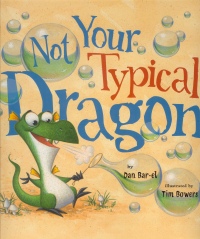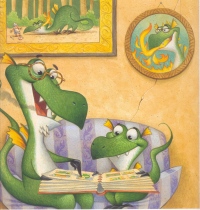| ________________
CM . . .
. Volume XIX Number 38. . . .May 31, 2013
In Not Your Typical Dragon, Dan Bar-el has created a warm and scaly retelling of the traditional hero story. Young Crispin Blaze has just turned seven, the age when dragons gain their fire-breathing abilities, but to his dismay, he cannot light his birthday candles. Through several trials and with the help of a new friend, Crispin discovers that, while he is not a typical dragon, his special gift can save the day.
Crispin and Sir George work together to solve Crispin's problem, his inability to breathe fire, without recognizing that it is not indeed a problem. An adult's solution, medicine, did not work, so these two young friends try to problem solve using their wits and resources. Crispin spies Sir George's book and suggests that maybe the solution can be found in it. They use the book to guide their problem-solving process by trying solutions proposed in the book one by one. Young readers can model on Crispin and Sir George's trial and error method in their own day-to-day problem solving. Even though their attempts are unsuccessful, they empower young readers to try to solve their own problems. This modeling of children problem solving parallels the process that young readers will go through as they read the book. They, too, are trying to figure out why Crispin cannot breathe fire. The use of repetition in the book allows young readers many chances to guess. When Crispin's father takes him to see the doctor, an activity that is treated as a normal, non-frightening occurrence, Crispin breathes out a spray of Band-Aids, an action which prompts a nurse to mention that they "were low on Band-Aids." Bar-el repeats these hints every time that Crispin breathes out something new. Such obvious hinting would be frustrating for a more sophisticated reader, but for a young reader, the repetition of these hints is necessary for them to guess what prompts Crispin to breathe out different things. Once the reader figures it out, the book very quickly wraps up in a final conflict and solution that reveals Crispin's talent. Throughout the book, Crispin's inability to breathe fire is treated as a problem by all the adults in his life, from his father to his doctor and teacher. It is so ingrained in Crispin by these three important figures that real dragons breathe fire that Crispin begins to believe that he is not a real dragon. By the end of the story, when only Crispin is able to save the day, his father realizes the mistake he has made in not recognizing his son's talent and defends Crispin as "something special". This final scene also shows young readers that adults are not omniscient and, like children, can learn from their mistakes. Not Your Typical Dragon is a positive story that could be used in the classroom, library and home environment to address the emotional and developmental needs of young children who are increasingly starting to interact with peers rather than adult caregivers. Friendship and acceptance are highlighted as two key themes. Bar-el and Bowers' book offers a playful and imaginative way to help an individual child to deal with being special or to foster empathy in a large group. Not Your Typical Dragon is an excellent addition to any library.
Highly Recommended. Sabrina Wong is a librarian at the University of Calgary in Calgary, AB.
To comment
on this title or this review, send mail to cm@umanitoba.ca.
Copyright © the Manitoba Library Association. Reproduction for personal
use is permitted only if this copyright notice is maintained. Any
other reproduction is prohibited without permission.
NEXT REVIEW |
TABLE OF CONTENTS FOR THIS ISSUE
- May 31, 2013.
AUTHORS |
TITLES |
MEDIA REVIEWS |
PROFILES |
BACK ISSUES |
SEARCH |
CMARCHIVE |
HOME |

 The plot of Not Your Typical Dragon is not new, but Bar-el reinvigorates it with an interesting twist. Rather than the knight as hero, this time the dragon is the protagonist and the knight his sidekick. After Crispin runs away from home, he meets a young knight, Sir George, who also feels like a failure. Together, these two unlikely friends devise ways for Crispin to breathe fire. The story is enlivened with Tim Bowers' hilarious and energetic illustrations. His use of acrylic paint on illustration board creates a vibrant and warm pictorial environment which reassures child readers that the story takes place in a safe, friendly place. While Crispin might face difficulties, there is the sense that a solution will be found and nothing too bad will happen during the course of the story. The facial illustrations bring personality and humour to the characters Bar-el has created. When Sir George and Crispin first meet, Bar-el describes Sir George as a "thin, shiny knight" with a "thin, shiny sword," shouting "D-d-do your worst, dragon!" Bowers' illustration shows a wide-eyed, knobby-kneed boy in armor meekly shouting at a bemused Crispin. This matching of physical traits to personality allows children to draw connections between the words that are being read to them and the pictures that they see on the page. Older readers might consider this literal translation to be overly simple, but for younger readers who are only beginning to draw these connections, Bar-el and Bowers have created the opportunity to understand how visual and word-based (traditional) literacy are connected in story.
The plot of Not Your Typical Dragon is not new, but Bar-el reinvigorates it with an interesting twist. Rather than the knight as hero, this time the dragon is the protagonist and the knight his sidekick. After Crispin runs away from home, he meets a young knight, Sir George, who also feels like a failure. Together, these two unlikely friends devise ways for Crispin to breathe fire. The story is enlivened with Tim Bowers' hilarious and energetic illustrations. His use of acrylic paint on illustration board creates a vibrant and warm pictorial environment which reassures child readers that the story takes place in a safe, friendly place. While Crispin might face difficulties, there is the sense that a solution will be found and nothing too bad will happen during the course of the story. The facial illustrations bring personality and humour to the characters Bar-el has created. When Sir George and Crispin first meet, Bar-el describes Sir George as a "thin, shiny knight" with a "thin, shiny sword," shouting "D-d-do your worst, dragon!" Bowers' illustration shows a wide-eyed, knobby-kneed boy in armor meekly shouting at a bemused Crispin. This matching of physical traits to personality allows children to draw connections between the words that are being read to them and the pictures that they see on the page. Older readers might consider this literal translation to be overly simple, but for younger readers who are only beginning to draw these connections, Bar-el and Bowers have created the opportunity to understand how visual and word-based (traditional) literacy are connected in story.